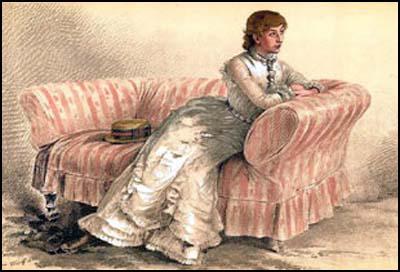
|

|
| This Web Site is dedicated to the Memories & Spirit of the Game as only Ken Aston could teach it... |
| Enjoy, your journey here on... KenAston.org |
| Ken Aston Referee Society ~ Football Encyclopedia Bible |
|
Lady Florence Dixie Administrators and Managers Female Footballers 
|
||
| Source - References | ||
|
||
 Lady Florence Dixie on the cover of Vanity Fair in 1884 |
||
|
Lady Dixie also wrote novels with a political message. She proposed
equality of the sexes in marriage and divorce, identical male and female
clothing and reform of the royal succession to allow the oldest child of
either sex to inherit the throne. A member of the National Union of
Women's Suffrage Societies she published The Revolution of 1900 in 1890.
Described as a feminist fantasy, the book features an heroine whose
activities lead to women winning the vote. The last chapter is set in
1999 where a peaceful and prosperous Britain is living under female
rule. Lady Dixie remained close to her twin brother James and she was devastated when he committed suicide by cutting his throat on 4th May 1891. Lord Dixie also had serious financial problems and was forced to sell his family home, Bosworth Hall. In 1895 Nettie Honeyball established the British Ladies Football Club. Lady Dixie agreed to become president on condition that "the girls should enter into the spirit of the game with heart and soul." She also arranged for the football team to tour Scotland. Lady Dixie arranged for the British Ladies teams to play some games in Scotland. The local newspaper poked fun at the women. One journalist commented: "One of the full-backs was suspected of playing in her brother's knickers. The fair player was frequently asked for the name of her tailor." |
||
 The North London side that played on 23rd March, 1895. Nettie Honeyball is second from the left in the top row. |
||
|
Other books by Lady Dixie included the novel Redeemed in Blood (1889).
She argued against the hunting of wild animals in The Horrors of Sport
(1891). In The Evolution of a Mind (1903), she expressed her growing
atheism and her views on the liberation of women. She also provided a
feminist introduction to Joseph McCabe's Religion of Woman (1905). Lady Florence Dixie died in 1905. |
||
| Source - References | ||
|
(1) Jan Toms, The Scotsman (23rd May, 2005) One bleak November morning, a funeral cortège wound its way across the windblown Kinmount estate in Dumfriesshire to a private burial ground. At an unmarked spot and in accordance with her instructions, Lady Florence Dixie - poet, travel writer, champion of women's rights and animal welfare - was laid to rest with no religious ceremony. Florence and her twin James Douglas were born on 25 May 1855, the last children of Archibald the 7th Marquis of Queensberry and Caroline his disillusioned wife. The twins were inseparable but it was an unequal partnership. The headstrong Florrie organized their lives while the indolent Jim followed. When they were age three their father met with a bizarre shooting accident widely rumored to be suicide. Their mother responded by converting to Catholicism and faced with the wrath of her mother-in-law, the Protestant Dowager Marchioness of Queensberry, she fled to France. Further turmoil followed. Reunited in Scotland, news arrived that the twins' brother Francis had died in a climbing accident. The distraught Caroline once again hauled the eight year olds around Europe. Unsettled and unhappy, Florence developed a need to travel that lasted into adulthood. On the shores of Lake Geneva, Bulwer Lytton spotted her sadness, inspiring him to write a poem, Little Florrie Douglas. Forty years later, Florrie dedicated her own book of poetry, Songs of a Child, to Lytton. |
| +-+ BACK TO TOP +-+ | |